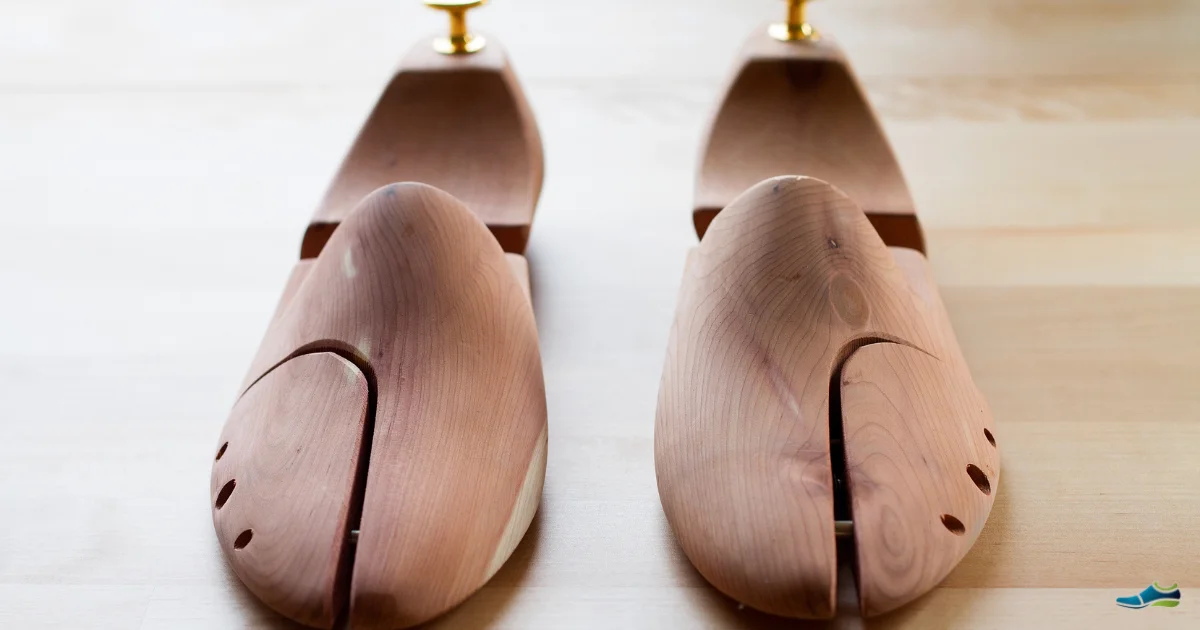We’ve all been there — you fall in love with a pair of shoes, only to find they pinch, squeeze, or rub when you first wear them. Whether it’s across the toes, the instep, or around a bunion, tight shoes are more than just annoying — they can cause blisters, corns, and lasting discomfort.
Unfortunately some shoes, no matter how often you wear them never give to your feet, and it’s your feet that call it a day first. Most of us have been there, still insisting that they’ll be ok, but it’s groundhog day again.
One common solution is the shoe stretcher. But do shoe stretchers work? or are they just another gimmick that ends up gathering dust in the cupboard? Let’s explore what they do, how they work, and whether they’re worth the investment.
If you’re stretching shoes often, it may be time to switch to true wide-fit footwear — learn more in our Wide Fit Shoes Guide
Do They Actually Work?
Yes — shoe stretchers can be highly effective when used correctly. Here’s what you can realistically expect:
- Width increase – most stretchers can easily add half a size in width, which is often enough to ease tightness.
- Length increase – a smaller improvement, usually a good half of a size.
- Spot relief – targeted plugs can make a big difference if you have bunions, hammertoes, or corns.
- Breaking-in aid – stretchers can soften the “new shoe stiffness,” making shoes more comfortable from the start.
- Height Increase – stretchers can increase the height of the toe box preventing the tops of the toes from rubbing the inside of the shoe
They won’t, however, magically turn a size 6 into a size 7. Think of them as fine-tuning, not total transformation.
Shoe Stretchers aren’t just for your new shoes
If you have found yourself with one or more foot conditions to contend with, it’s fair to assume that you have a wardrobe full of footwear that doesn’t fit as they once did and are gathering dust.
Now is definitely the right time to consider a set of shoe or boot stretchers, particularly if the shoes are in good order, still fashionable and were expensive when new.
Aside from the initial cost of the stretchers, once set to your feet, the results are very personalised and something no amount of money can buy in a shop. The results can be like having someone else wear them in without you having to endure the discomfort.

Our late Queen Elizabeth II had someone with almost identical feet to wear in her new shoes for her. For the rest of us, shoe stretchers run a pretty close second.
Alternative Ways to Stretch Shoes at Home
While shoe stretchers are the most reliable option, a few other methods can give you a little extra comfort in a pinch:
1. Thick Socks & Gentle Wear-In
Slip on a pair of thick socks, then wear your shoes around the house for 20–30 minutes. The added bulk stretches the shoe slightly while protecting your feet from blisters.
- Works best with leather or canvas.
- Don’t overdo it — too much pressure can distort the shoe’s shape.
2. The Freezer Trick (Use With Caution)
This one sounds odd but can work. Fill two small freezer bags with water, place them inside your shoes, then freeze overnight. As the water expands into ice, it gently pushes the material out.
- Best for sturdy shoes like leather or synthetic trainers.
- Always double-bag the water to avoid leaks.
- Avoid suede, fabric, or delicate leathers — they can warp or stain.
3. Professional Stretching Services
Cobblers often offer stretching with specialised machines that apply heat and pressure in controlled spots. This is especially useful for delicate materials or expensive pairs you don’t want to risk at home.
These tricks won’t replace a stretcher if you need serious width or toe box space, but they can make tight shoes more wearable for casual use.
What is a Shoe Stretcher?
A shoe stretcher is a device designed to expand the fit of a shoe. They come in different types:
- Two-way stretchers – widen shoes across their width and length.
- One-way stretchers – usually focus on width only.
- Boot stretchers – built to handle taller shafts of boots.
- Spot stretchers or plugs – target specific pressure points like bunions or corns.
- Toe Box Raiser/Stretchers – increase height of the toe box, perfect for hammer toes.
Most are made of wood or durable plastic with adjustable metal parts that allow gradual expansion.
How Do Shoe Stretchers Work?
Shoe stretchers apply gentle, consistent pressure from the inside. Instead of forcing your foot to break in the shoe (which can be painful), the stretcher slowly encourages the shoe’s material to relax and reshape.
For best results, many people pair stretchers with shoe stretcher sprays or liquids, which soften leather and fabric fibres, making them more pliable. The stretcher then holds the shoe in the new shape until it sets.
Benefits of Using Shoe Stretchers
1. Comfort Without Pain
Instead of enduring weeks of blisters while breaking shoes in, you can start wearing them comfortably much sooner.
2. Cost Savings
If you own shoes that are too tight to wear but too expensive to throw away, a stretcher can bring them back into rotation.
3. Custom Fit
Everyone’s feet are unique. A good stretcher lets you tailor shoes to your specific shape, whether that’s a wide forefoot, a high instep, or a sensitive bunion.
4. Shoe Preservation
Stretchers allow gradual, even expansion, which is much safer for leather than forcing it to stretch while walking.
Limitations of Shoe Stretchers
While they work well, they aren’t a perfect solution in every case:
- Material matters – leather and suede stretch beautifully, but synthetics and stiff plastics don’t respond as well.
- Limited stretch – you’ll usually only gain a half-size adjustment. If shoes are far too small, they can’t be saved.
- Patience required – stretching is gradual; leaving the stretcher in overnight or longer is usually necessary.
- Care needed – overstretching can deform shoes or make them too loose.
When Are Shoe Stretchers Most Useful?
- For leather shoes that are too tight
- Breaking in dress shoes without weeks of sore feet
- Relieving pressure from bunions or corns
- Widening vintage or second-hand shoes that fit closely
- Making seasonal shoes wearable again after your feet swell (e.g., during summer or pregnancy)
When They Might Not Be Worth It
- Shoes made from synthetic materials that won’t stretch much.
- Footwear that’s more than a size too small.
- Shoes already badly worn or fragile, where stretching could cause damage. (read about choosing shoes to reduce foot pain)
Tips for Best Results
- Use a shoe stretcher spray to soften the material before stretching.
- Work in small increments — tighten gradually rather than forcing expansion.
- Leave it overnight or up to 24 hours for stubborn shoes.
- Always test first if using sprays on delicate leathers or suedes.
- If stretching boots, get a boot-specific stretcher for proper reach.
Frequently Asked Questions
Q: How much can a shoe stretcher actually stretch a shoe?
A: Usually about half a size in width and a few millimetres in length. They’re best for easing tight spots, not changing shoe size completely.
Q: Do shoe stretchers work on all shoe types?
A: They’re most effective on leather and suede. Canvas can stretch a little, but synthetics and plastics rarely respond well.
Q: Can I damage my shoes with a stretcher?
A: Only if you overdo it. Gentle, gradual adjustments are safe, but rushing can crack leather or deform the shoe.
Q: Do I need a spray with a shoe stretcher?
A: Not essential, but sprays speed things up by softening fibres, giving a smoother stretch and reducing the chance of cracking.
Q: Can I stretch shoes in the freezer?
A: Yes, though it’s a bit of a hack. Water-filled bags expand into ice and nudge the material outward. It works on sturdier shoes, but avoid delicate fabrics and always seal the bags well to prevent leaks.
Q: Will thick socks help loosen shoes?
A: Wearing thick socks while walking around at home can ease snugness in leather or canvas shoes. It’s slower than a stretcher but handy for softening new shoes without too much effort.
Conclusion
So, do shoe stretchers work? Absolutely — provided your shoes are made from stretchable materials and you only need a modest adjustment. They’re one of the simplest, most cost-effective tools for easing discomfort, extending shoe life, and avoiding the pain of breaking in tight shoes.
They may not work miracles, but for anyone who has struggled with pinching shoes, they’re a worthwhile addition to your footcare tool kit.
If your shoes are very well worn, there may not be any stretch left so it may be worth considering a fresh start, my Complete Guide to Wide Fit Shoes will explain the things to look for.

